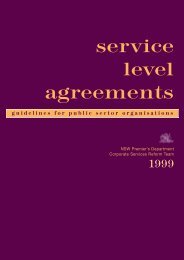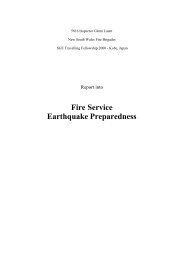Identify and respond to children and young people at risk - NSW ...
Identify and respond to children and young people at risk - NSW ...
Identify and respond to children and young people at risk - NSW ...
Create successful ePaper yourself
Turn your PDF publications into a flip-book with our unique Google optimized e-Paper software.
<strong>and</strong> acknowledges their humanity. . Set <strong>and</strong> maintain clear boundaries of<br />
acceptable <strong>and</strong> professional interactions when working with older <strong>children</strong> <strong>and</strong><br />
<strong>young</strong> <strong>people</strong>. This means taking care th<strong>at</strong> your rel<strong>at</strong>ionship cannot be<br />
interpreted by the child, <strong>young</strong> person or an outsider as based on a personal<br />
r<strong>at</strong>her than professional interest.<br />
Confidentiality – inform<strong>at</strong>ion about a child, <strong>young</strong> person or their family/carer is<br />
kept priv<strong>at</strong>e <strong>and</strong> only shared according <strong>to</strong> legal <strong>and</strong> organis<strong>at</strong>ional directions.<br />
Transparency – maintaining clarity with the family about the requirements of<br />
the work th<strong>at</strong> the worker is responsible for undertaking. This may mean<br />
balancing hopefulness about the potential of family members with recognition of<br />
the issues th<strong>at</strong> they are facing, <strong>and</strong> the likely consequences if change cannot be<br />
achieved or if organis<strong>at</strong>ional expect<strong>at</strong>ions (for example maintaining a safe<br />
workplace) are not respected. It also involves being clear about wh<strong>at</strong> the<br />
worker <strong>and</strong> organis<strong>at</strong>ion can <strong>and</strong> can’t offer.<br />
Consistency – Being trustworthy, reliable <strong>and</strong> predictable so as much as<br />
possible the child, <strong>young</strong> person, family <strong>and</strong>/or carer know wh<strong>at</strong> <strong>to</strong> expect,<br />
including th<strong>at</strong> any commitments made will be followed through.<br />
Focus on client need – The objective is <strong>to</strong> address the needs of the child, <strong>young</strong><br />
person, family <strong>and</strong>/or carer, not <strong>to</strong> prioritise their own needs <strong>to</strong> be liked, or <strong>to</strong><br />
be recognised. It also means an oblig<strong>at</strong>ion <strong>to</strong> provide services even where there<br />
may be issues in engaging <strong>children</strong>, <strong>young</strong> persons, family <strong>and</strong>/or carers, while<br />
recognising workplace oblig<strong>at</strong>ions <strong>and</strong> polices regarding a safe workplace.<br />
Maintaining professional boundaries requires an awareness of the worker’s own<br />
values <strong>and</strong> beliefs, as distinct from those of the client.<br />
4. If participants refer <strong>to</strong> challenges in maintaining professional<br />
boundaries in rel<strong>at</strong>ion <strong>to</strong> child focused practice, acknowledge<br />
these, <strong>and</strong> note th<strong>at</strong> there will be more discussion of ethical<br />
issues l<strong>at</strong>er in the day.<br />
2.4. Duty of care<br />
These concepts are summarised for participants in<br />
H<strong>and</strong>out 5: Maintaining professional boundaries.<br />
1. Explain the concept of duty of care, drawing <strong>at</strong>tention <strong>to</strong> H<strong>and</strong>out<br />
6: Duty of care when working with <strong>children</strong>, <strong>young</strong> <strong>people</strong> <strong>and</strong><br />
families.<br />
Duty of care applies <strong>to</strong> a range of situ<strong>at</strong>ions <strong>and</strong> can be briefly<br />
described as the oblig<strong>at</strong>ion th<strong>at</strong> a sensible person would have in the<br />
circumstances when acting <strong>to</strong>ward others <strong>and</strong> the public. It is<br />
important <strong>to</strong> see duty of care not only as steps taking <strong>to</strong> avoid<br />
litig<strong>at</strong>ion, but as a framework for good practice.<br />
2. Explain th<strong>at</strong> there is a high degree of care owed <strong>to</strong> <strong>children</strong><br />
because of their vulnerability.<br />
Keep Them Safe CHCCHILD401A – Facilita<strong>to</strong>r’s Manual<br />
© The <strong>NSW</strong> Technical <strong>and</strong> Further Educ<strong>at</strong>ion Commission<br />
(TAFE <strong>NSW</strong> – Industry Skills Unit, Meadowbank, 2010)<br />
18







